Getting these animals tipsy and stabbing them through the eye with a stake turns out to be much less impressive than when Odysseus did it.
For vertebrates we find no cyclopses. On some fish, frogs, lizards and relatives there is a third eye (a “parietal eye”) directly on the tops of their heads (middle photo below), which is cyclops-like in not being paired with another eye. However, although these eyes are light-sensitive, they are not really eyes at all because they are not capable of forming an image of the outside world. Instead, they seem to be involved in thermoregulation, although no one is quite sure.
The closest thing higher vertebrates have to cyclopses are anencephalic infants, like the kitten shown below. But that’s nature’s mistake.
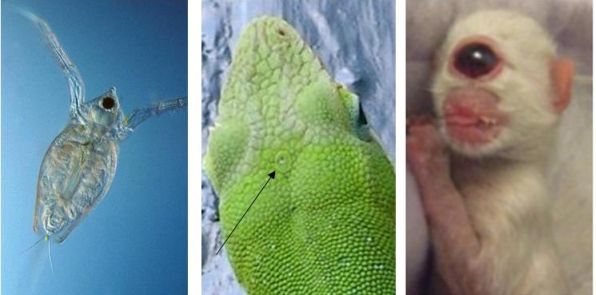
One reason for the scarcity of cyclopses is that they can’t see what’s behind them.
Most of the Earth’s animals with vision, however, can see much of what’s behind them, and presumably need to.
They do this via having two eyes facing in opposite directions.
This is true, for example, of squid, insects, fish, reptiles, dinosaurs, birds, and many mammals like rabbits and horses (see photos below). You can’t sneak up on these animals from behind.
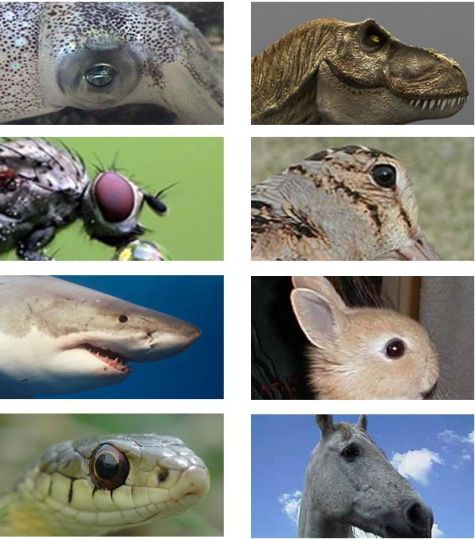
Let’s take notice of something so obvious about the animals pictured above that one is apt to overlook it.
These animals have eyes facing in opposite directions, as I mentioned, but more specifically their eyes are on the sides of their heads, so that the eyes point sideways, as in the drawing of the animal on the left, below.
But this is not the only possible way of having panoramic vision.
One could instead place a single eye on the very front of the head, and another on the very back, as illustrated below and on the right. You never find this in nature (and not even in fiction, as far as I know). Why not?
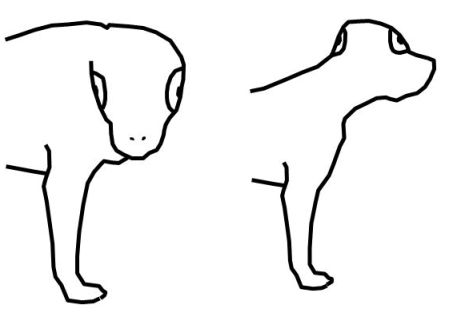
The reason has to do with the fact that those sideways-facing eyes earlier don’t just see the opposite sides of the animal.
Instead, they typically also have some overlap, i.e., parts of the world that both eyes can see, called the binocular region.
Seeing a part of the world via two eyes has certain advantages, advantages that animals typically want to bring to bear in front of themselves.
For animals with sideways-facing eyes, the binocular region does tend to be in front.
For example, for the drawing of the animal above and on the left, you are in its binocular field because you can tell that each of its eyes can see you.
For animals with an eye on the front of its head and another on the back, however, any overlapping regions of the visual field would be along the sides of the animal, not the front.
…and animals don’t tend to want their especially powerful vision directed to the sides.
Our vision is a variant of having eyes on the sides of the head in the sense that our eyes are placed on the left and right of our midline, and so our binocular region is also in front.
What are these advantages of binocular vision for seeing the world?
The typical answer that would be given by anyone knowing anything about vision will be stereo vision, or the ability to see in depth. The study of binocular vision is so historically wrapped up with stereo vision that courses and books about binocular vision tend to be largely about this special kind of depth perception.
Contrary to conventional wisdom, however, in my research I have come to appreciate a power of binocular vision no one has yet noticed: the power to see through stuff. As I discuss in my book, The Vision Revolution, understanding this “x-ray power” is crucial for understanding why we have forward-facing eyes.
But in this piece I want to point out a special, very fundamental, kind of “x-ray vision” binocular vision gives us, one that helps further drive home the advantages to panoramic vision via sideways-facing eyes rather than via front-and-back-facing eyes.
…It is the power to see through yourself.
Before an animal can worry about how to most ably see what’s out there in the world, it has to make sure it can actually see what’s out there. A fancy eyeball placed on the inside roof of its mouth would not see much of the world.
But where should you put the eyes?
Most spots will be better than the roof of the mouth, but bodies tend to have gangly parts that could possibly block an eye’s view.
And, in fact, one typically wants some of those body parts to be out in front of the eye, body parts like a mouth, nose, whiskers or hands that are designed to physically interact with the things out in front. Animals want these appendages out in front of the eye not only because these appendages are good at touching the world and eyes are not, but also because it is useful to see one’s own appendages so as to help guide the appendages’ interactions with the world.
And that leads to a riddle that animals with vision had to solve.
Namely, how can they put appendages out in front of their eyes, yet not occlude their view of the world?
This is a riddle that video game makers have had to grapple with as well. How do you let the player see his own character without obstructing the view of the game?
If you play games in first-person perspective mode, then if your character is holding a gun or sword, its arm and weapon occlude a significant portion of the screen (see the upper image below).
If you play in third-person perspective mode—where you see the entire character from behind—then there are also significant parts of the view missing due to the character’s whole body blocking the view (see the lower image below).
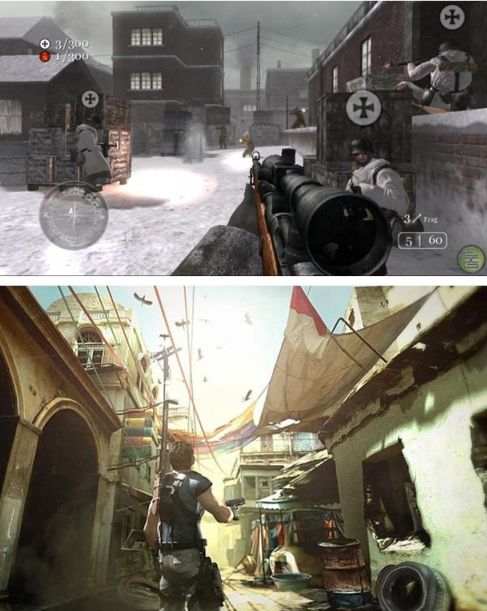
That’s why many games allow the player’s viewpoint to roam around the character -- rather than being locked with a view of the character’s back. Allowing our eyes to float steady-cam style around our bodies and relay information to our brains would, then, be a potential solution to the problem of seeing past our own appendages.
Nature found a different solution, however, and you can see it for yourself by looking at your own nose.
If you close one eye and wiggle your nose, you’ll see it in the bottom corner, blocking that eye’s view of whatever’s beyond it, as illustrated in the pair of upper images in the figure below.
But, if you now open the other eye you’ll see what’s behind your nose via this other eye (illustrated by the lower image below).
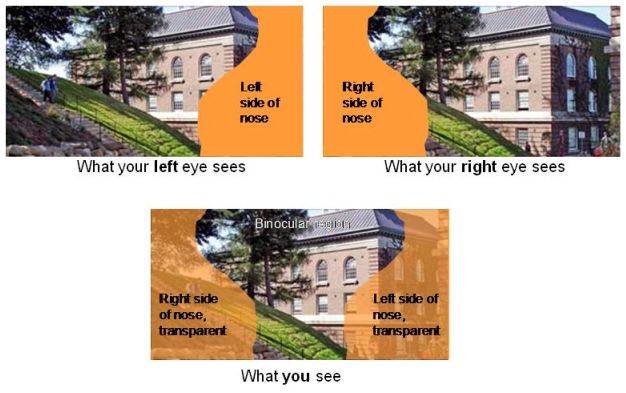
In fact, you’ll perceive your nose still to be there, but perceive it to be transparent through which you are seeing the scene beyond. Each eye sees the nose, and each has its view blocked by the nose. But the views blocked by the nose are different for each eye, so the pair of eyes, in total, don’t miss a thing. …and yet can also see your nose.
If, instead, an animal’s eyes were on the front and back of its head, then the appendages out in front of the front eye would simply occlude its view.
Having eyes on the sides of the head (or on either side of the midline, like ours) rather than on the front and back is not only, then, useful for placing the powerful binocular region in front of the animal for the purpose of better perception of what’s out there.
In addition, having eyes on the sides of the head is crucial for seeing past one’s own bodily appendages.
And not just seeing past one’s own appendages, but simultaneously seeing them and thereby having the advantages that come with having this visual feedback.
See through oneself may be one of the most fundamental reasons why animals have eyes on either side of their head and possess a binocular region.
~~~~
This was adapted from Chapter 2 of The Vision Revolution (Benbella, 2009).




Comments